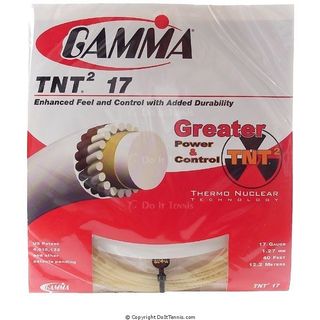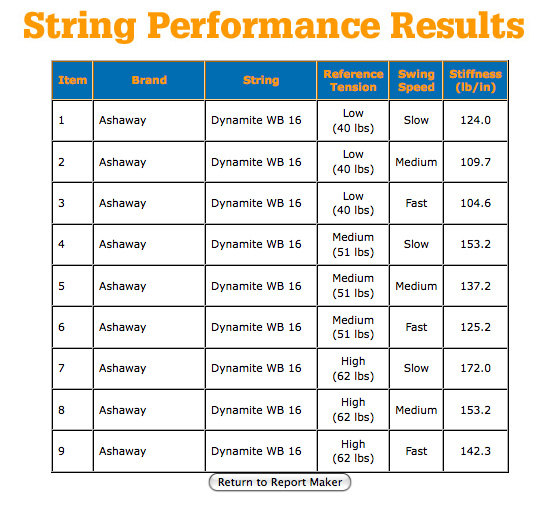Centered
Hall of Fame
Strings were strung at 62 lbs. Stiffness is the number before tension loss.
Stiffest Kevlar (non-blend):
Prince Problend w/Duraflex 16 (Main), 981, 16 lbs
Gosen Arammix Pro 16, 795, 19 lbs
Ashaway Kevlar 16, 764, 27 lbs
Softest Kevlar (non-blend) and/or Technora:
Forten Ultra Thin Blend (Main) 18, 545, 15 lbs
Forten Thin Blend 18/17 (Main), 557, 14 lbs
Wilson Hyperlast Spin 19 (Main), Technora, 562, 14 lbs
Softest Kevlar/nylon blend and/or Vectran:
Ashaway Composite XL Pro 15, 444, 16 lbs
Ashaway Composite XT Pro 16, Vectran, 470, 14 lbs
Pacific Powercraft 18, 508, 15 lbs
Stiffest poly:
Pacific Poly Force 16L, 320, 18 lbs
Gamma Dura Blast 16 , 303, 13 lbs
Babolat Revenge 16, 302, 19 lbs
Stiffest nylon monofilament ("synthetic gut"):
Ashaway MonoGut 16L, 242, 19 lbs
Wilson Ultra Synthetic Gut 15L, 238, 14 lbs
Dunlop X Life Synthetic, 236, 15 lbs
Stiffest nylon multi:
Wilson NXT Tour 16, 219, 9 lbs
Gosen Nanocubic 16, 217, 11 lbs
Alpha Sphere 16, 216, 14 lbs
Softest poly:
Babolat Pro Hurricane 18, 187, 22 lbs
Head Sonic Pro 17, 199, 23 lbs
Pacific Poly Power 18, 201, 21 lbs
Stiffest and softest poly blend multis:
Tecnifibre Promix 17, Nylon/poly, 199, 14 lbs
Isospeed Energetic 16 , Polypropylene/poly, 175, 19 lbs
Softest nylon monofilament core ("synthetic gut"):
Pacific Power Twist 16L, 175, 13 lbs
Head Synthetic Gut PPS 18, 176, 12 lbs
Pacific Power Twist 16, 179, 12 lbs
Stiffest and softest Zyex (sorry, Klip Zyex and Bow Brand were not tested):
Ashaway Dynamite WB 16, 165, 13 lbs
Ashaway Dynamite 17 , 147, 14 lbs
Stiffest and softest polyolefin:
Isospeed Control 16, 158, 16 lbs
Head Intellistring 17 (Cross)/Intellitour 17 (Cross), 136, 15 lbs
Softest nylon multi:
Head Perfect Power 17, 144, 15 lbs
Gamma Professional 18, 144, 15 lbs
Alpha Gut 2000 18, 146, 15 lbs
Stiffest gut:
Grand Slam Gut Grand Slam Gut 15L (uncoated), 129, 11 lbs
Babolat Tonic+ Thermogut Longevity, 119, 9 lbs
Babolat VS Touch Thermogut 15L, 118, 9 lbs
Softest gut:
Pacific Tough Gut 16L, 83, 8 lbs
Pacific Tough Gut 16, 88, 7 lbs
Pacific Classic Gut 16L , 92, 6 lbs
data
Stiffest Kevlar (non-blend):
Prince Problend w/Duraflex 16 (Main), 981, 16 lbs
Gosen Arammix Pro 16, 795, 19 lbs
Ashaway Kevlar 16, 764, 27 lbs
Softest Kevlar (non-blend) and/or Technora:
Forten Ultra Thin Blend (Main) 18, 545, 15 lbs
Forten Thin Blend 18/17 (Main), 557, 14 lbs
Wilson Hyperlast Spin 19 (Main), Technora, 562, 14 lbs
Softest Kevlar/nylon blend and/or Vectran:
Ashaway Composite XL Pro 15, 444, 16 lbs
Ashaway Composite XT Pro 16, Vectran, 470, 14 lbs
Pacific Powercraft 18, 508, 15 lbs
Stiffest poly:
Pacific Poly Force 16L, 320, 18 lbs
Gamma Dura Blast 16 , 303, 13 lbs
Babolat Revenge 16, 302, 19 lbs
Stiffest nylon monofilament ("synthetic gut"):
Ashaway MonoGut 16L, 242, 19 lbs
Wilson Ultra Synthetic Gut 15L, 238, 14 lbs
Dunlop X Life Synthetic, 236, 15 lbs
Stiffest nylon multi:
Wilson NXT Tour 16, 219, 9 lbs
Gosen Nanocubic 16, 217, 11 lbs
Alpha Sphere 16, 216, 14 lbs
Softest poly:
Babolat Pro Hurricane 18, 187, 22 lbs
Head Sonic Pro 17, 199, 23 lbs
Pacific Poly Power 18, 201, 21 lbs
Stiffest and softest poly blend multis:
Tecnifibre Promix 17, Nylon/poly, 199, 14 lbs
Isospeed Energetic 16 , Polypropylene/poly, 175, 19 lbs
Softest nylon monofilament core ("synthetic gut"):
Pacific Power Twist 16L, 175, 13 lbs
Head Synthetic Gut PPS 18, 176, 12 lbs
Pacific Power Twist 16, 179, 12 lbs
Stiffest and softest Zyex (sorry, Klip Zyex and Bow Brand were not tested):
Ashaway Dynamite WB 16, 165, 13 lbs
Ashaway Dynamite 17 , 147, 14 lbs
Stiffest and softest polyolefin:
Isospeed Control 16, 158, 16 lbs
Head Intellistring 17 (Cross)/Intellitour 17 (Cross), 136, 15 lbs
Softest nylon multi:
Head Perfect Power 17, 144, 15 lbs
Gamma Professional 18, 144, 15 lbs
Alpha Gut 2000 18, 146, 15 lbs
Stiffest gut:
Grand Slam Gut Grand Slam Gut 15L (uncoated), 129, 11 lbs
Babolat Tonic+ Thermogut Longevity, 119, 9 lbs
Babolat VS Touch Thermogut 15L, 118, 9 lbs
Softest gut:
Pacific Tough Gut 16L, 83, 8 lbs
Pacific Tough Gut 16, 88, 7 lbs
Pacific Classic Gut 16L , 92, 6 lbs
data
Last edited:


